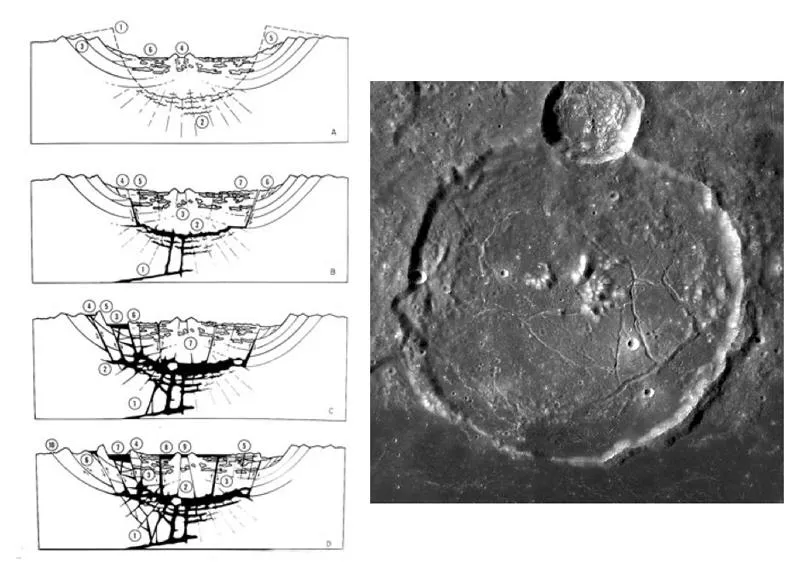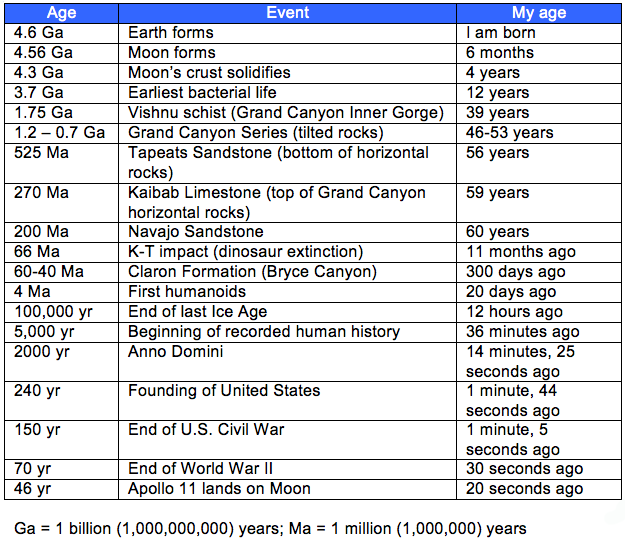Could the Colorado Plateau Be an Ancient Impact Scar?
Conjectures on a road trip across the American West
/https://tf-cmsv2-smithsonianmag-media.s3.amazonaws.com/filer/e8/08/e808ef03-5455-48df-8f4b-92cf26050299/canyonlands-spudis.jpg)
I recently had occasion to make an extended car trip across the western United States, traveling from Denver to Las Vegas, across the province called the Colorado Plateau. This region is a spectacularly beautiful part of the country, a region of vast high deserts, deep canyons and colorful layered rocks. I planned our journey to take in 10 National Parks and Monuments that reveal the pristine beauty of this region. As we slowly traversed the region, my thoughts drifted to questions of time and origin. (A geologist is always thinking on the job, even on vacation!)
The Colorado Plateau occupies the corners of four states: Colorado, New Mexico, Utah and Arizona. It is roughly circular in plan and approximately 375 miles (600 km) across. It is made up of a series of layered sedimentary rocks (see photo above), the vast bulk of which are surprisingly undeformed, considering that the plateau is bounded by the Rocky Mountains in the north and east, and the Basin and Range province in the west and south. The reason we see so much geology exposed on the plateau is that it is relatively arid, with little to no vegetation; the steep gradients of the Colorado River basin (which encompasses several other rivers) have cut deep canyons into the rock, exposing them for our inspection and consideration.
The rocks of the plateau span almost the compete range of ages of rocks on our continent, from the Precambrian crystalline rocks of the Inner Gorge of the Grand Canyon (about 1.7 billion years old), up through a complete section of sediments from the Cambrian (500 million years old) to the capping lavas that are only a few thousand years old. No one place shows all the rocks, but exposures are relatively close together—in one half day, you can see the oldest rocks of the Grand Canyon Inner Gorge to the highest rocks at the Canyon (the Permian Kaibab limestone) through the Mesozoic strata that make up the “Grand Staircase” of southern Utah, which is topped by relatively recent Tertiary limestones and Holocene (prehistoric) basaltic lava flows. You can stand at the base of a 1000-foot (300 m) cliff and contemplate, with sheer awe, the record of 100 million years of geologic time on display before you. This area has attracted geologists for years; I went to geology field camp here 40 years ago and it is still as stunning as I had remembered.
While traveling across this vast region, my thoughts drifted (as they often do) to the Moon and its features. A vast circular region of flat-lying rocks ….hmm? It sounds a lot like the filled, circular impact basins of the Moon, gigantic craters that were subsequently flooded by the eruption of a layered series of thin flows of basaltic lava. But there are differences as well as similarities. The mare basins on the Moon are topographic lows; they were even deeper holes before flooding by lava. The Colorado Plateau is an elevated area, most of it lying well above one-to-two miles (2-5 km) above sea level. There is no evidence of a massive impact being responsible for the creation of the Plateau. But other factors must be considered.
When I took a course in meteorites years ago, Carleton Moore (then Director of the Center for Meteorite Studies at Arizona State University) once mentioned the Colorado Plateau and asked (hypothetically) how long the Earth might “remember” such an a enormous impact scar. This off-hand remark remained with me for many years and was lit anew during my sojourn. There may be a feature on the Moon analogous to the Plateau. Most large lunar impact craters look remarkably similar to each other—deep cavities with raised rims, features that gradually erode with time as other craters form on top of them. In some cases, however, the interiors of craters are uplifted, either as a single plate or with a slight doming action, stretching and deforming the crater floor with cracks and faults. Sometimes, lava is erupted from these cracks. These features are called “floor-fractured craters” and were first recognized and discussed by my colleague Peter Schultz in 1976.

Schultz proposed that magma (liquid rock) had been injected beneath the floor of these craters and the floor (made up of an impact melt sheet and associated breccias) was uplifted as a plate. Unable to support its own weight, the floor had fractured in consequence.
Could the Colorado Plateau be a terrestrial floor-fractured impact crater? Admittedly, this is a fairly outrageous idea. The Plateau is much larger across (375 miles, or ~600 km) than typical floor-fractured craters on the Moon (30-60 miles, or 50-100 km). The Plateau has been dissected through erosion by running water, which obscures surface features, but extensional faults predominate (as it does in floor-fractured craters). There is evidence for considerable post-Plateau volcanism (basalt lava flows) in several areas and even evidence for the intrusion of significant volumes of magma, deforming the overlying, flat sedimentary deposits (e.g., the Henry Mountains of Utah). There is no rock evidence for the presence of a large, 600 km-diameter impact basin (e.g., shock metamorphic features in mineral grains or impact melts), but such evidence might exist far below the surface of the Earth. This impact (if real) would have occurred billions of years ago, in the Precambrian, where the rock record is spotty and poorly exposed.
How might this all have worked? A large asteroid colliding with the Earth would excavate thousands of cubic kilometers of crust, depositing this debris around and outside the feature and creating a large topographic and structural depression within. Over time, as seas advanced and retreated across the landscape and the rim deposits were eroded, the basin would accumulate sediment. All of the flat rocks of the Plateau have been created as water-lain and wind-blown sediments, which would have slowly filled the large depositional basin over hundreds of millions of years (recent mudslides in California attest to how easily landscapes are altered). These flat strata are largely undeformed, showing only minor folding (e.g., the Waterpocket monocline in Capitol Reef National Park) associated with crustal adjustment, truly remarkable considering the ages that they span. Some process has uplifted the Plateau, an event difficult to explain outside of some type of thermal gradient (e.g., plume) in the deep crust and mantle of the Earth. It was probably not a simple injection of magma, as proposed for floor-fractured craters on the Moon, but rather an extended upward “push” generated by the heat engine of the Earth. A few minor volcanic eruptions that cap the sediments complete the analogy with lunar floor-fractured craters.
This scenario is far-fetched, but when one considers the awesome expanse of geological time, almost anything can be imagined, if not fulfilled. It is difficult for people to envision the immensity of geologic time, as they tend to reckon time spans in relation to their own lives. To provide perspective, I have done this for major events in the history of the Earth and Moon, scaled to my own life.

Think about the entire extent of a single human life as a model for the age of the Earth-Moon system: I am 63 and the Earth formed when I was born. The Moon doesn’t appear until a chance, giant impact creates the Earth-Moon double-planet system about 6 months later. The early history of the Earth is obscure, but we know that the Moon was largely molten until 4.3 billion years ago (I am now 4 years old). Evidence for the earliest recognizable life forms on Earth (carbon excreted from fossil microbes) occurs around 3.7 billions years ago (I’m a mere 12 years old). The oldest rocks in the Grand Canyon are 1.7 billion years (I’ve now reached 39 years) and the entire sequence of Colorado Plateau sediments correspond to the interval between my 46th and 63rd birthdays. The first human-like creatures appeared on Earth only about 20 days ago, recorded human history began about a half-hour ago, and all the events of my own life are compressed into the last 30 seconds. This crude analogy shows the true vastness of geologic time; it also impresses upon us that much of our understanding of Earth’s biography is as limited and incomplete as someone trying to reconstruct the story of my life from a few snapshots and dates available in the table.
I don’t know if the Colorado Plateau represents an ancient impact basin, but stranger ideas than this one have ultimately turned out to hold at least a grain of truth. Geologists deal with the anciently remote and seemingly unknowable on a daily basis. Mark Twain once characterized science as “wholesale returns of conjecture out of such a trifling investment of fact.” That the facts are minimal here is not debated. But facts have consequences and we follow them where they lead, sometimes into seemingly preposterous depths. Conjecture? Sure. But the alternative would be uncharacteristic indifference to what came before and a foolish dismissal of what lies ahead.
Stay curious my friend.
/https://tf-cmsv2-smithsonianmag-media.s3.amazonaws.com/accounts/headshot/blog_headshot_spudis-300x300.jpg)
/https://tf-cmsv2-smithsonianmag-media.s3.amazonaws.com/accounts/headshot/blog_headshot_spudis-300x300.jpg)